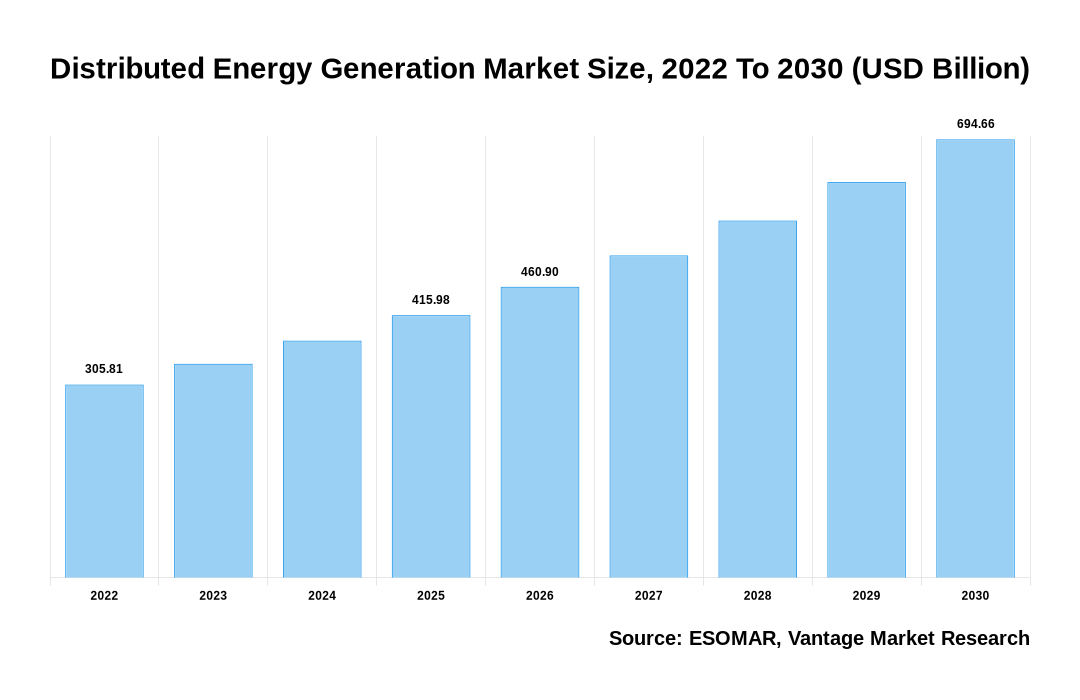Global Distributed Energy Generation Market
As stated in our extensive report; the Global Distributed Energy Generation Market accounted for USD 276.8 Billion in the year 2021.
Over the forecast period, the market is anticipated to be driven by rising environmental awareness, expanding government regulations and goals for greenhouse gas (GHG) emission reductions, and rising energy consumption. Increased R&D efforts to create new technologies are also anticipated to support the market expansion. The market for DEG systems is likely to be fueled by government initiatives and incentives, including feed-in tariffs in North America and the Asia Pacific. The installation of such systems in industrial, residential, and commercial applications is being encouraged by government programs. Depending on the application and the area, these systems can be run both on and off the grid.

Click To Get a Free Sample On the Research Study
Key factors influencing Distributed Energy Generation Market Growth
The growth of the global Distributed Energy Generation market can be attributable to the following:
- Since electricity has become a necessity of modern living, its demand is snowballing worldwide. Therefore, a change has occurred toward using renewable energy sources to produce electricity to keep up with the growing demand.
- Additionally, investors are drawn to renewable energy generation since it is supported by the government’s stringent green energy targets.
- To provide a small-scale power generation alternative or complement to the conventional electric power infrastructure, distributed energy generation technologies are used. Distributed energy can be produced using both renewable and nonrenewable energy resources.
- Due to distributed generation, energy can be produced from various sources, including the wind, sun, reciprocating engines, turbines, biomass, and more. Another advantage of distributed generation is that it eliminates the need for long-distance power transmission lines by enabling energy production in off-the-grid locations.
- Microgrids gather energy from numerous sources, consuming only what is required and sending the surplus to the grid. In addition, off-grid gadgets can store any extra energy in batteries for later use.
- The primary barrier preventing the market’s expansion is a reluctance to invest in distributed generation technologies because it is expensive, time-consuming, and labor-intensive to transform existing centralized business models into decentralized ones.
- The market is expanding as more individuals become aware of alternative energy options. The market for distributed energy generation is being propelled by the increased demand for a distributed generation due to its advantages over traditional energy in terms of the environment and the reduced cost of a distributed generation.
- The need for distributed generation systems is also rising, driving the global distributed generation market expansion. This is due to technological breakthroughs, improvements, and convenience of use.
- Growing government regulations, rising government ambitions for reducing greenhouse gas emissions, and rising energy consumption are driving the market for distributed energy generation.
- Additionally, anticipated market growth is increased research and development efforts to create new technologies. Government initiatives and incentives, including feed-in tariffs in North America and Asia Pacific, are anticipated to increase demand for distributed energy generation systems. Government programs promote the installation of such systems in commercial, residential, and industrial settings.
- Rising environmental concerns, government initiatives offering tax breaks, incentives for installing solar panels, and the prohibitive cost of grid expansion are anticipated to be significant market drivers.
- Additionally, technical developments that have reduced the cost of producing solar panels and improved efficiency have been significant drivers of the market growth for distributed energy generation.
- Market expansion has been hampered in Asia-Pacific by a need for more public awareness and interest in technology.
- Due to strict energy efficiency rules, European manufacturers have been compelled to coordinate their efforts toward sustainable energy installations. For instance, the top market players are creating eco-friendly transformers and microgrid infrastructure, which benefits the corporate environment.
- Furthermore, the market for distributed power generation will grow due to the current electrification regime and the growing attention paid to decentralized energy production.
Asia Pacific Region to Lead the Market
Asia Pacific Distributed Energy Generation market is getting more significant with maximum market share during the forecast period. The main driver of market expansion is projected to be the increased need for energy due to the rising population and rapid urbanization in nations like India, China, Indonesia, and Malaysia. The nation’s urban cities play a significant role in meeting product demand, especially in China. The Chinese market is anticipated to be driven by the rising levels of disposable income in the nation.
Conclusion
Rising environmental awareness, expanding government regulations, and goals for greenhouse gas (GHG) emission reductions are positively influencing the overall Distributed Energy Generation market.
Some of the key players in the Global Distributed Energy Generation Market include- Vestas (Denmark), Caterpillar (U.S.), Capstone Green Energy Corporation (U.S.), Doosan Heavy Industries & Construction (South Korea), Toyota Tsusho Corporation (Japan), Rolls-Royce PLC (U.K.), General Electric (U.S.) and others.
![[Market Research Reports] – Research Google News Blog | VMR.Biz](https://www.vmr.biz/wp-content/uploads/2022/12/logo-removebg-preview.png)











